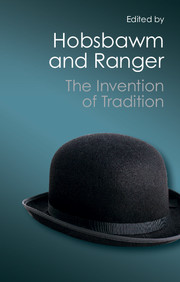Book contents
- Frontmatter
- Contents
- Contributors
- 1 Introduction: Inventing Traditions
- 2 The Invention of Tradition: The Highland Tradition of Scotland
- 3 From a Death to a View: The Hunt for the Welsh Past in the Romantic Period
- 4 The Context, Performance and Meaning of Ritual: The British Monarchy and the ‘Invention of Tradition’, c. 1820–1977
- 5 Representing Authority in Victorian India
- 6 The Invention of Tradition in Colonial Africa
- 7 Mass-Producing Traditions: Europe, 1870–1914
- Index
5 - Representing Authority in Victorian India
Published online by Cambridge University Press: 05 July 2014
- Frontmatter
- Contents
- Contributors
- 1 Introduction: Inventing Traditions
- 2 The Invention of Tradition: The Highland Tradition of Scotland
- 3 From a Death to a View: The Hunt for the Welsh Past in the Romantic Period
- 4 The Context, Performance and Meaning of Ritual: The British Monarchy and the ‘Invention of Tradition’, c. 1820–1977
- 5 Representing Authority in Victorian India
- 6 The Invention of Tradition in Colonial Africa
- 7 Mass-Producing Traditions: Europe, 1870–1914
- Index
Summary
CULTURAL CONTRADICTIONS IN THE CONSTRUCTION OF A RITUAL IDIOM
By the middle of the nineteenth century, India's colonial society was marked by a sharp disjunction between a small, alien ruling group, British in culture, and a quarter of a billion Indians whom the British effectively controlled. The military superiority of these aliens had just been successfully demonstrated in the brutal suppression of a widespread military and civil revolt which had spread through much of Upper India in 1857 and 1858. In the two decades that followed this military action, a theory of authority became codified, based on ideas and assumptions about the proper ordering of groups in Indian society, and their relationship to their British rulers. In conceptual terms, the British, who had started their rule as ‘Outsiders’, became ‘insiders’ by vesting in their monarch the sovereignty of India through the Government of India Act of 2 August 1858. This new relationship between the British monarch, her Indian subjects and the native princes of India was proclaimed in all principal centres of British rule in India on 8 November 1858. In the proclamation Queen Victoria assured the Indian princes that ‘their rights, dignity and honour’ as well as their control over their territorial possessions would be respected, and that the queen ‘was bound to the natives of Our Indian territories by the same obligations of duty which bind us to all our other subjects’. All her Indian subjects were to be secure in the practice of their religions.
- Type
- Chapter
- Information
- The Invention of Tradition , pp. 165 - 210Publisher: Cambridge University PressPrint publication year: 2012
- 16
- Cited by



